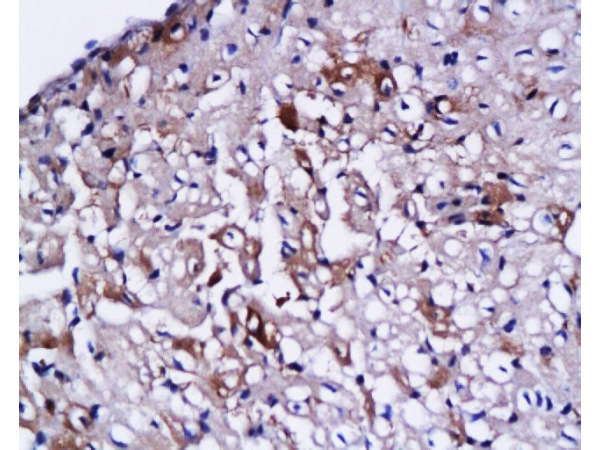Cardiac Troponin I antibody [N1C3]
GTX109331
ApplicationsWestern Blot, ImmunoHistoChemistry, ImmunoHistoChemistry Paraffin
Product group Antibodies
ReactivityHuman, Mouse, Rat
TargetTNNI3
Overview
- SupplierGeneTex
- Product NameCardiac Troponin I antibody [N1C3]
- Delivery Days Customer9
- Application Supplier NoteWB: 1:1000-1:10000. IHC-P: 1:100-1:1000. *Optimal dilutions/concentrations should be determined by the researcher.Not tested in other applications.
- ApplicationsWestern Blot, ImmunoHistoChemistry, ImmunoHistoChemistry Paraffin
- CertificationResearch Use Only
- ClonalityPolyclonal
- Concentration0.05 mg/ml
- ConjugateUnconjugated
- Gene ID7137
- Target nameTNNI3
- Target descriptiontroponin I3, cardiac type
- Target synonymsCMD1FF, CMD2A, CMH7, RCM1, TNNC1, cTnI, troponin I, cardiac muscle, cardiomyopathy, dilated 2A (autosomal recessive), troponin I type 3 (cardiac)
- HostRabbit
- IsotypeIgG
- Protein IDP19429
- Protein NameTroponin I, cardiac muscle
- Scientific DescriptionTroponin I (TnI), along with troponin T (TnT) and troponin C (TnC), is one of 3 subunits that form the troponin complex of the thin filaments of striated muscle. TnI is the inhibitory subunit; blocking actin-myosin interactions and thereby mediating striated muscle relaxation. The TnI subfamily contains three genes: TnI-skeletal-fast-twitch, TnI-skeletal-slow-twitch, and TnI-cardiac. This gene encodes the TnI-cardiac protein and is exclusively expressed in cardiac muscle tissues. Mutations in this gene cause familial hypertrophic cardiomyopathy type 7 (CMH7) and familial restrictive cardiomyopathy (RCM). [provided by RefSeq]
- ReactivityHuman, Mouse, Rat
- Storage Instruction-20°C or -80°C,2°C to 8°C
- UNSPSC12352203
References
- Shan SS, Lu SY, Yang YP, et al. A Two-Electrode, Double-Pulsed Sensor Readout Circuit for Cardiac Troponin I Measurement. IEEE Trans Biomed Circuits Syst. 2020,14(6):1362-1370. doi: 10.1109/TBCAS.2020.3029912Read this paper
- Crestani T, Steichen C, Neri E, et al. Electrical stimulation applied during differentiation drives the hiPSC-CMs towards a mature cardiac conduction-like cells. Biochem Biophys Res Commun. 2020,533(3):376-382. doi: 10.1016/j.bbrc.2020.09.021Read this paper






![IHC-P analysis of ovary tissue using GTX83501 Cardiac Troponin I antibody [4A3]. Antigen retrieval : Heat-induced epitope retrieval by 10mM citrate buffer, pH6.0, 100oC for 10min. Dilution : 1:50](https://www.genetex.com/upload/website/prouct_img/normal/GTX83501/GTX83501_1485_IHC-P_w_23061419_300.webp)